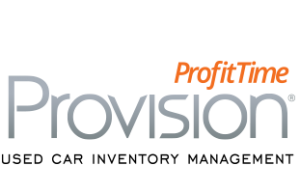A Provision ProfitTime Pricing Primer
For much of the past decade, dealers have determined how to price used vehicles based on a unit’s inventory age.
That is, dealers would set less-competitive prices on fresh vehicles,  and get more price-aggressive as a vehicle met/passed days-in-inventory milestones. For example, a vehicle might start at a 98 percent to 100 percent Price to Market ratio for the first seven days and then, at specific calendar intervals, the Price to Market ratio would drop as dealers reduced their asking prices.
and get more price-aggressive as a vehicle met/passed days-in-inventory milestones. For example, a vehicle might start at a 98 percent to 100 percent Price to Market ratio for the first seven days and then, at specific calendar intervals, the Price to Market ratio would drop as dealers reduced their asking prices.
This pricing practice has served dealers well over the years—except for the fact that it doesn’t necessarily account for whether you own the car right, or whether it really makes sense to apply the same Price to Market range or ratio to different vehicles, just because they happen to have been in your inventory for the same number of days.
Thankfully, Provision ProfitTime addresses these age- or calendar-based pricing shortcomings by focusing on each vehicle’s unique investment value, in terms of your market, your profit objectives and other vehicles in your inventory.
With ProfitTIme, you know right away if a vehicle merits an initial asking price of a 100 percent Price to Market ratio or better. The system’s investment score for individual vehicles, and the precious metal designations from Platinum to Bronze, give you more insight into how to properly price a vehicle in the context of its competitive set and your profit/retail objectives.
But I’ve come to understand that ProfitTime-driven pricing raises a lot of questions about exactly how to properly price vehicles based on investment value, and not just days in inventory. You might even say there’s some confusion on this topic, which seems particularly strong among dealers and managers for whom age- or calendar-based pricing is now first nature.
I thought I would use this post to help clarify how investment value-based pricing seems to work best for dealers who adopt it.
First, it’s important to understand that a vehicle’s investment score is one of three key metrics ProfitTime renders for every vehicle. In addition to the score, ProfitTime offers a read on the vehicle’s appeal in the market, assigning a letter grade (A-F). In addition, ProfitTime assesses the degree to which you need a particular vehicle, identifying if you’re long/short with a particular unit in your inventory.
Second, it’s crucial to understand that these three metrics—the ProfitTime investment score, the letter grade and the plus/minus designation that informs how much you may need a particular unit—represent what might be called a trifecta, or trinity, that brings greater certainty and clarity to each pricing decision. Together, these metrics help answer an age-old question—“how competitively priced do I need to be with this particular car?”
Third, I think that as dealers consider the trifecta of metrics for each vehicle, they should probably give greater weight to the investment score. After all, the score, whether good or bad, is the single-best indicator of whether the vehicle is a good candidate as a gross profit- or volume-generating unit, or something in between.
To illustrate what I mean, let’s work through a few examples with vehicles we’ll presume we’ve just acquired. We’ll also assume each vehicle has a competitive set of 15 vehicles:
Example 1: Let’s say you have a vehicle with an investment score of 3 (a Bronze unit), a C- grade, and you already have 11 of them in your inventory. In this case, the vehicle’s not the greatest investment, and you don’t really need it, but you own it. In my view, this vehicle should be priced to retail quickly, which means it should rank first or second out of the competitive set of 15 vehicles to generate immediate buyer attention and interest.
Example 2: Let’s say you have a vehicle with an investment score of 3, it’s a B-minus, and you need four in your inventory. In this instance, the vehicle isn’t the best investment, but it’s a pretty good car and, since you and your market needs it, you probably don’t need to be as price competitive. It seems appropriate to price this vehicle third, fourth or fifth in the competitive set.
Example 3: Let’s say you have a vehicle with an investment score of 7 (Gold), it’s a C-minus, and you have three similar units in your inventory. In this case, the car’s investment value would seem to merit a stronger price position, perhaps ranked seventh or eighth in the competitive set of 15 vehicles.
Example 4: Let’s say you have a vehicle with an investment score of 10 (Platinum), a B-plus and I need eight more. In this instance, the vehicle’s a great investment, it’s a solid car and the market wants it. If I were a dealer, I’d price this vehicle to rank 12th or 13th in the competitive set.
Example 5: Let’s say you have a vehicle with an investment score of 10 (Platinum), a C-minus and you have three more in your inventory. In this case, I might price the vehicle to rank ninth or 10th in the competitive set of 15 vehicles—a slightly more aggressive position than the vehicle in Example 4, due to this vehicle’s lower letter grade.
You’ll notice that in each of these examples, the vehicles were all “fresh” cars. Yet, because of their individual investment values, and the respective assessments of the metrics in the trifecta, each vehicle ends up in its own competitive price position on Day 1. There’s no standard application of a Price to Market range or ratio just because each vehicle is “fresh.”
In my view, this ProfitTime-driven approach to pricing will ultimately drive better results for dealers. Each car can truly stand on its own investment value, irrespective of the date on a calendar.
I should note that, when dealers execute an investment value-based pricing strategy, they must be honest and realistic about what constitutes a “competitive set.” The strategy may also require re-thinking how frequently today’s market requires revisiting your competitive sets and adjusting used vehicle prices.
I’ll take up both topics in my next post.
The post A Provision ProfitTime Pricing Primer appeared first on Dale Pollak.

















